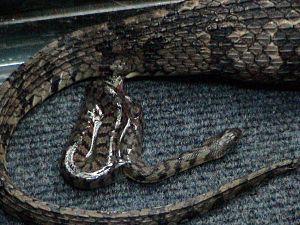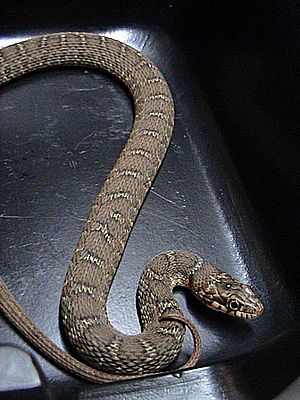Nerodia facts for kids
Quick facts for kids Nerodia |
|
|---|---|
 |
|
| Nerodia rhombifer, diamondback water snake | |
| Scientific classification |
|
| Kingdom: | Animalia |
| Phylum: | Chordata |
| Class: | Reptilia |
| Order: | Squamata |
| Suborder: | Serpentes |
| Family: | Colubridae |
| Subfamily: | Natricinae |
| Genus: | Nerodia Baird & Girard, 1853 |
| Synonyms | |
|
Clonophis, Coluber, Ischnognathus, Natrix, Regina, Storeria, Tropidoclonion, Tropidonothus, Tropidonotus, Vipera |
|
Nerodia is a group of snakes often called water snakes because they love living in or near water. These snakes are not venomous, meaning their bites are not poisonous. There are nine different types of Nerodia snakes, and they all live in North America. Some of these types even have smaller groups called subspecies.
Contents
About Water Snakes
Nerodia snakes come in many shapes and sizes, but they are usually quite thick-bodied. They can grow to be about 1.2 meters (4 feet) long or even more! They have flat heads with small, round eyes. Their scales on their back are "keeled," which means they have a ridge down the middle, making them feel rough.
Some water snakes, like the banded water snake (N. fasciata), have clear stripes. Others, like the plainbelly water snake (N. erythrogaster), have blotches. The diamondback water snake (N. rhombifer) has cool diamond patterns. Most of these snakes are brown or olive green, with markings that are brown or black. Sometimes, they have yellow or cream-colored spots too.
How Water Snakes Behave
As their name suggests, Nerodia snakes spend most of their time in or very close to water. You can often spot them warming up in the sun on tree branches that hang over slow-moving streams or ponds. They are excellent swimmers and divers.
What Water Snakes Eat
Water snakes mainly eat fish and amphibians like frogs and salamanders. They are very good at catching their food in the water. They might also eat small reptiles or rodents that live near the water's edge.
How Water Snakes Defend Themselves
When a water snake feels threatened, its first reaction is to try and get away. But if they can't escape, they will defend themselves. They might strike or bite if someone tries to handle them. They can also release a stinky, musky smell from their body, which helps to scare away predators.
Water Snake Reproduction

Nerodia snakes give birth to live young, just like mammals do. They don't lay eggs. They usually breed in the spring, and the baby snakes are born in late summer or early fall. A mother water snake can have many babies, sometimes more than 90, but usually, the group of babies is smaller. When they are born, baby water snakes are about 20 to 26 centimeters (8 to 10 inches) long.
Types of Water Snakes
There are several recognized types of Nerodia snakes and their subspecies. Here are a few examples:
- Nerodia clarkii – known as the salt marsh snake.
- Nerodia cyclopion – the green water snake.
- Nerodia erythrogaster – the plainbelly water snake, which includes the copperbelly water snake.
- Nerodia fasciata – the banded water snake.
- Nerodia rhombifer – the diamondback water snake.
- Nerodia sipedon – the common water snake.
- Nerodia taxispilota – the brown water snake.
Where Water Snakes Live
Nerodia snakes are found across the southern and eastern parts of the United States. Their range extends north into Canada and south into Mexico, and even to the island of Cuba. Different types of water snakes often live in the same areas.
For example:
- The salt marsh snake (N. clarkii) lives around the Gulf of Mexico and in Cuba.
- The green water snake (N. cyclopion) is found in many states from Texas to South Carolina.
- The plainbelly water snake (N. erythrogaster) lives across a wide area from Texas all the way to Michigan and into Mexico.
- The common water snake (N. sipedon) has a very large range, from Colorado to Maine and up into Canada.
Water Snakes as Pets
Because water snakes are very common in the wild, you can often find them in the pet trade in the United States. However, they are not usually bred in captivity. Most people don't choose them as pets because they aren't as colorful as some other snakes, and they tend to bite if handled. Still, they are easy to care for and can do well as pets.
Protecting Water Snakes
Most Nerodia species are not considered endangered or threatened. However, some types, like N. harteri and N. paucimaculata, are only found in small areas and are protected by state laws.
Water snakes are often mistaken for the venomous cottonmouth snake (Agkistrodon piscivorus). Because of this, many more water snakes are sadly killed each year than cottonmouths, simply because people are afraid or don't know the difference. This happens even in places where cottonmouths don't live.
See also
 In Spanish: Nerodia para niños
In Spanish: Nerodia para niños


